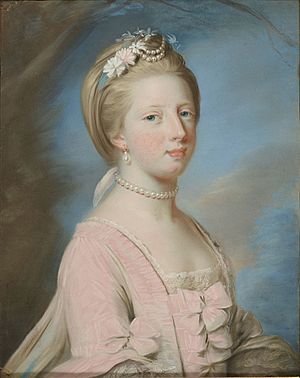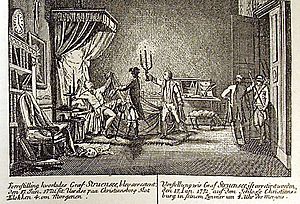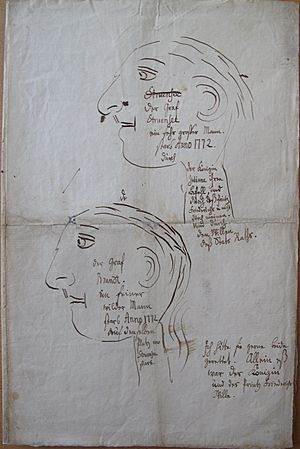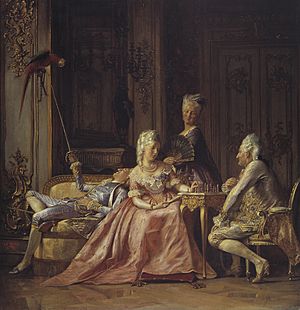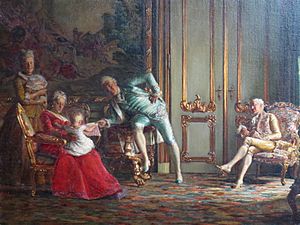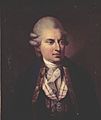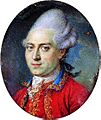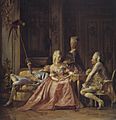Johann Friedrich Struensee facts for kids
Quick facts for kids
Johann Friedrich Struensee
|
|
|---|---|
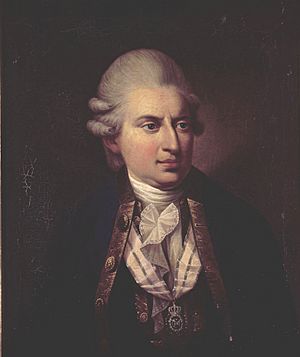
Posthumous portrait by Hans Hansen
|
|
| Privy Councillor of Denmark | |
| Predecessor | Johann Hartwig Ernst von Bernstorff |
| Successor | Ove Høegh-Guldberg |
| Born | 5 August 1737 Halle an der Saale, Kingdom of Prussia |
| Died | 28 April 1772 (aged 34) Copenhagen, Kingdom of Denmark-Norway |
| Issue | Princess Louise Augusta of Denmark (avowedly) |
| Occupation | Physician |
Johann Friedrich Struensee (born August 5, 1737 – died April 28, 1772) was a doctor and a smart thinker from Germany who became very powerful in Denmark. He started as the personal doctor for King Christian VII of Denmark, who was not well. Struensee became a top government official and tried to make many big changes to the country. His close relationship with Queen Caroline Matilda and his growing power led to many challenges and eventually his downfall.
Contents
Early Life and Education
Johann Friedrich Struensee was born in Halle an der Saale, Germany, on August 5, 1737. He was one of six children in a family that believed in religious freedom. His father was a minister.
At the age of 15, Struensee started studying medicine at the University of Halle. He became a doctor in 1757. At the university, he learned about the Age of Enlightenment, which was a time of new ideas about society and government. He liked these new ideas and believed in freedom of thought.
In 1758, Struensee moved to Altona, a city in Germany. He worked there as a public doctor. His pay was not very high, so he also saw private patients. He was known for being intelligent and having interesting, sometimes controversial, ideas.
Struensee was ambitious. He wrote articles about Enlightenment ideas in his own journal called Zum Nutzen und Vergnügen (which means "For benefit and enjoyment").
Becoming the King's Doctor
While living in Altona, Struensee met some important people who had been sent away from the royal court in Copenhagen. These people, like Enevold Brandt and Count Schack Carl Rantzau, supported the new ideas of the Enlightenment.
Count Rantzau suggested Struensee to the Danish court. He thought Struensee would be a good doctor for King Christian VII. The King was planning a trip to other royal courts in Europe.
Struensee got the job in April 1768. He traveled with the King for eight months. During this trip, he earned the King's trust and friendship. The King's ministers were happy because Struensee seemed to help the King behave better.
When they returned to Copenhagen in January 1769, Struensee became the King's personal doctor. In May, he received the special title of State Councillor. This made him an important person at court. Struensee also wrote an important report about the King's mental health.
Struensee's Growing Influence
Struensee helped the King and Queen become friends again. At first, Queen Caroline Matilda did not like Struensee. She was unhappy in her marriage and felt alone because the King was often ill and ignored her.
Struensee was one of the few people who paid attention to the Queen. He tried his best to help her. Over time, the Queen grew to like him. By the spring of 1770, he became very close to her. His influence grew even more when he successfully vaccinated the baby Crown Prince in May.
Struensee also took a big role in raising Crown Prince Frederick VI of Denmark. He believed in the ideas of the Enlightenment thinker Jean-Jacques Rousseau. Struensee wanted the Prince to be independent and learn on his own. He even made sure the Prince was lightly dressed, even in winter, believing it was good for him.
Taking Control of the Government
On May 5, 1770, Struensee was named a royal adviser. As the year went on, King Christian VII became more and more unwell. Struensee's power grew stronger and stronger. The period of 16 months when Struensee was in charge is often called the "Time of Struensee."
At first, Struensee worked quietly behind the scenes. But as the royal court spent the summer of 1770 in Schleswig-Holstein, his power became even greater. In December 1770, he took a big step. He ended the council of state, which was the main government body.
A week later, he made himself maître des requêtes. This meant it was his job to present reports from all government departments to the King. Since the King was not able to make decisions, Struensee simply wrote down whatever answers he wanted.
Next, he fired all the heads of government departments. He also ended the position of the governor-general of Norway. From then on, the cabinet, with Struensee in charge, became the only authority in the country. Struensee had almost complete control for about 13 months, from December 18, 1770, to January 16, 1772. During this time, he issued over 1,000 new government orders.

Struensee's Reforms
Struensee wanted to modernize Denmark. He introduced many changes, including:
- Ending the use of torture.
- Ending forced labor for peasants.
- Allowing complete freedom of the press.
- Stopping the practice of giving state jobs only to nobles.
- Ending special privileges for nobles.
- Stopping "undeserved" payments to nobles.
- Changing the strict rules of behavior at the Royal Court.
- Reducing the number of nobles at the Royal Court.
- Stopping government money for factories that were not productive.
- Reducing the number of public holidays.
- Adding a tax on gambling and luxury horses to help fund care for abandoned children.
- Banning the slave trade in Danish colonies.
- Giving special titles and awards only for real achievements.
- Making bribery a crime and punishing it.
- Changing the courts to reduce corruption.
- Creating state-owned grain storage to keep grain prices stable.
- Giving farmland to peasants.
- Changing and reducing the size of the army.
- Reforming the universities.
- Improving state-owned medical facilities.
He also stopped other unfair practices, like giving public jobs to the household staff of powerful men.
Challenges to Struensee's Rule
Some people criticized Struensee because he did not respect Danish and Norwegian traditions. They felt he saw these traditions as old-fashioned and wanted to get rid of them. He also did not speak Danish and did all his work in German.
To make sure his orders were followed, he fired many government workers without giving them pensions. He replaced them with his own choices. Many of these new officials were not experienced and knew little about the country they were supposed to govern.
At first, many Danish people liked his reforms. But they started to turn against him. When Struensee allowed complete freedom of the press, it led to many pamphlets being published that criticized him.
People were also upset because he seemed to completely ignore the King. Many believed the King was not truly mad, but just weak-willed. This feeling grew stronger when Struensee was given the power to issue orders that had the same force as royal laws, even without the King's signature.
Struensee's close relationship with the Queen also upset many people. The way the Queen behaved in public caused a scandal. The group of people around the King and Queen also seemed to make fun of the King. Sometimes, the King would try to resist orders from Struensee or Brandt, another official. Once, the King even got into a physical struggle with Brandt.
Arrest and Execution
Struensee had fired many government officials and army officers. This created many enemies for him. On November 30, 1771, he made himself and Brandt counts. These actions made many people in Denmark and Norway feel uneasy and unhappy.
In the summer of 1771, the King, Queen, Struensee, Brandt, and others stayed at Hirschholm Palace. On July 7, the Queen gave birth to a daughter, Louise Augusta.
The general anger against Struensee grew throughout the autumn of 1771. A plan was made to remove him from power. This plan was led by Schack Carl Rantzau and others, who acted on behalf of the Queen Dowager Juliana Maria of Brunswick-Wolfenbüttel. They wanted to take power from the King and secure their own positions.
On January 17, 1772, early in the morning, Struensee, Brandt, and Queen Caroline Matilda were arrested in their bedrooms. The people of Copenhagen celebrated, believing the King had been freed. The King was driven around Copenhagen in a gold carriage, and everyone cheered.
The main charge against Struensee was that he had taken over the King's power, which was against the country's laws. He defended himself well. At first, he denied his relationship with the Queen was against the law, thinking they would not dare to accuse the Queen. The Queen was taken as a prisoner to Kronborg Castle.
On April 27 and 28, Struensee and Brandt were sentenced to a severe punishment. They were to lose their right hands and then be beheaded. Their bodies were then to be cut into pieces. The law did not have rules for a king who was mentally ill. However, Struensee was a common person who had gained power among the nobles. He was found guilty of disrespecting the King and taking royal power. These were serious crimes under the law.
Struensee waited for his execution at Kastellet, Copenhagen. The sentences were carried out on April 28, 1772. Brandt was executed first.
Even after Struensee's death, the King himself thought Struensee was a great man. In 1775, three years after the execution, the King made a drawing and wrote in German: Ich hätte gern beide gerettet ("I would have liked to have saved them both"). He was referring to Struensee and Brandt.
Struensee in Art and Stories
Struensee's life, his relationship with the Queen, and his connection with the King have been shown in many artistic works.
Books
- 1935: The Favourite of the Queen by Robert Neumann
- 1948: The Queen's Physician by Edgar Maass
- 1953: Converse at Night in Copenhagen by Karen Blixen
- 1969: The Lost Queen by Norah Lofts
- 1999: The Visit of the Royal Physician by Per Olov Enquist
Stage Plays and Ballets
- 1827: Struensee – a play by Michael Beer with music by his brother Giacomo Meyerbeer.
- 1991: Caroline Mathilde – a ballet by the Royal Danish Ballet.
- 2008: The Visit of the Royal Physician – an opera based on Enquist's novel.
Movies
- 1923: The Love of a Queen – a German silent film.
- 1935: The Dictator – a British film where Struensee was played by Clive Brook.
- 1957: King in Shadow – a West German film based on Neumann's novel.
- 2012: A Royal Affair – a Danish film nominated for an Academy Award, starring Mads Mikkelsen as Struensee.
Images for kids
-
The Kingdom of Denmark–Norway
See also
 In Spanish: Johann Friedrich Struensee para niños
In Spanish: Johann Friedrich Struensee para niños



